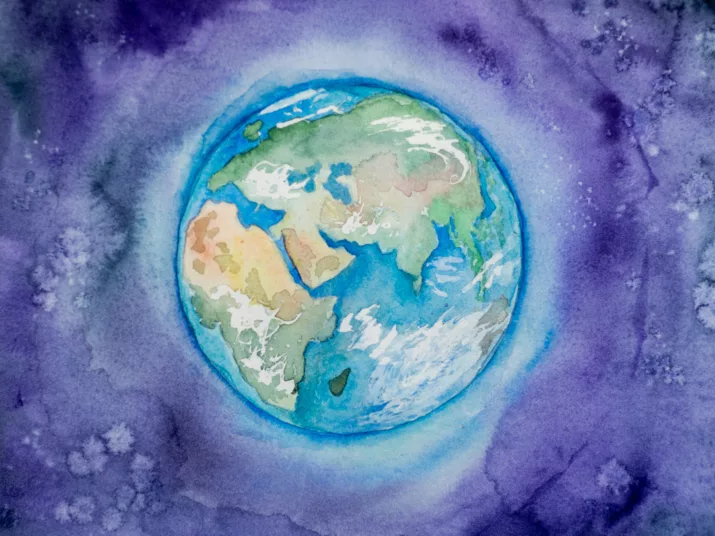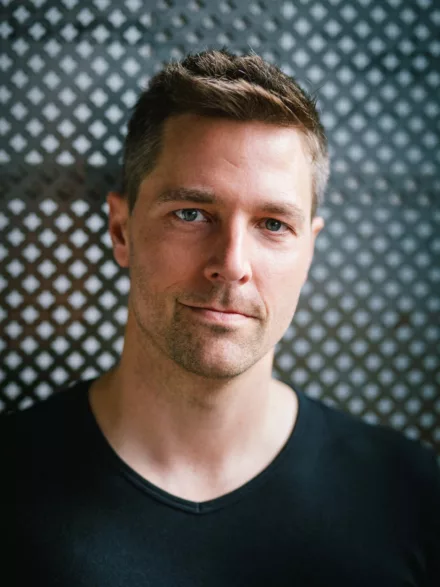
Political scientist Frederic Hanusch in an interview about planetary thinking and what it has to do with our democracy
How can we think like a planet?
Climate change, species extinction and environmental destruction – the impact of human activities on our planet is undisputed. How can we change our relationship with the Earth and preserve it for future generations? And how can democracies contribute towards this? The political scientist Dr Frederic Hanusch explores the interrelation between democracies and planetary change and argues in favour of more “planetary thinking”. In conversation with Magali Mohr-Ahlers, research associate at Futurium, he explains how we might think like a planet and what planetary policies and institutions might look like.

Magali Mohr: Dear Frederic, here at Futurium we’re looking into the question of how to steel democracies for the future. Where do you see the biggest challenges in terms of the ability of democracies to deal with the future?
Frederic Hanusch: I think one of the biggest challenges is that we’ve put our democracies in a situation where they’re increasingly reactive rather than formative. Extreme weather events like the flood in the Ahr Valley in 2021 or the increasing number of forest fires are examples that have made us realise the incredible sums of investment money we need to have ready to repair climate-related damage. This money will then not be available in other places and this narrows the room for manoeuvre available for shaping the future of democracy.
MM: Naturally, the question that immediately comes to mind is how we can again expand democracy’s room for manoeuvre. One of the ideas you’re focussing on at the Panel on Planetary Thinking is: how can we think like a planet?
The interviewee
Frederic Hanusch is scientific director of the “Panel on Planetary Thinking” at Justus Liebig University Giessen. Currently, he is a fellow at THE NEW INSTITUTE in Hamburg as part of the programme “The Future of Democracy”.
He is working on a book titled “The Politics of Deep Time” that explores how long-lasting institutions oriented towards long-term thinking would need to be designed.

FH: The dominant paradigm in recent decades, especially after 1990, has been that of globalisation. And this concept has always been very anthropocentric, meaning, it’s focussed on humans. The main area of interest is the Earth’s surface, which is inhabited by humans, and the question of how we can get the best out of it for ourselves. Meanwhile, we’ve come to understand that the entire planet Earth – from its interior to its atmosphere – interacts with how we act on and with it. We’ve neglected this way of thinking so far.
We’re always dealing with different Earths
MM: So it’s about living with the planet, not just on it?
FH: Exactly. We’re not just living on a planet – we’re part of it. And our planet isn’t static either, but as the scientists Nigel Clark and Bronislaw Szerszynski put it in their book “Planetary Social Thought”, we’re constantly dealing with different Earths. Throughout human history, the Earth has always been a very changeable planet instead of a fixed background against which we operate. The two authors call these different phases of planet Earth – which might eventually become totally covered with ice and then at another stage dry up completely – “planetary multiplicity”.
MM: Planetary thinking is a concept based on the planet’s perspective instead of the human perspective. However, the reality is that humans have caused all these developments. How is planetary thinking compatible with the Anthropocene?
FH: The Anthropocene is a part of planetary thinking. But the planetary perspective goes beyond that. For example, in the Cretaceous period, the North American continent was in formation. Back then, it consisted of several larger pieces of land, with the sea level higher and the coast further inland. In the area of today’s state of Alabama, which was covered with water back then, the shifting of the continental plates caused plankton to die over a long period of time. As a result, the soil in this area has been very fertile ever since. That was between 70 and 100 million years ago. Then human history kicked in and interacted. If you look at maps, you’ll notice that especially large cotton plantations were built exactly in the particularly fertile areas containing the plankton deposits. From the 18th century onwards, African slaves were then used and exploited on these cotton plantations. In the long term, this has led to a particularly high proportion of black people in the area. That, in turn, helped Democrat Joe Biden get elected in the 2020 national election in that very region, while Republican Donald Trump won the rest of Alabama. What I’m saying is that, in principle, you can draw a direct connection from Earth’s history – in this case, plankton deposits at some point in time – to the political situation today. So planetary thinking is not just about ecological connections, but just as much about social and political ones.
MM: That’s very exciting!
FH: So it’s really about thinking ahead in terms of time and space, even into interplanetary space.
Planetary thinking is not just about ecological connections, but just as much about social and political ones
MM: But the approach of planetary thinking isn’t entirely new, is it? You didn’t think that up yourselves, did you?
FH: No, especially among indigenous peoples, it’s a common way of thinking. They often assume an interaction of all living beings and even of matter. For example, according to the cosmology of many Aborigines, “what happens on earth is reflected in heaven”. Indigenous societies have acquired incredible knowledge about nature and the environment that surrounds them.
MM: And what does all this imply for our democracy, in concrete terms? What does planetary policy look like?
FH: That’s something we’re still in the process of figuring out. But there are already some exciting approaches. For example, we can use the latest technologies, for instance sensor technology, to investigate how healthy our forests are. Through sensors, we can determine the water content or heat stress in forests. And in the interest of a planetary policy, we can then ask ourselves whether, based on this data, the ecosystem shouldn’t be granted something like a political will or voice. The idea would be to use the collected data for the purpose of representing the interests of the ecosystems in question in the political process.
MM: I find this vision very exciting. However, those with an interest in climate protection are already very far apart even today and we’re having huge difficulties achieving a common climate policy, especially at the global level. And now you’re saying global is really not enough and that we actually need a planetary policy. How is that supposed to work? Are there any concrete ideas on how to directly integrate this into today’s system?
FH: Yes, there are some quite exciting ideas out there. For example, the scientists Anthony Burke and Stefanie Fishel propose a kind of citizens’ council at the global level with representatives for the 15 biomes, the Earth’s regional ecosystems. This Earth system council would be based at the United Nations and, similar to the Security Council’s mission of peace, would be concerned with safeguarding the ecosystems.
A citizens’ council at the global level, with representatives for the 15 biomes of the Earth
MM: I would like to return to the issue of democratic institutions and how they might evolve in the future. I read that you coined the term “deep time organizations”. What do you mean by this?
FH: Well, many processes or goals – like climate change or preserving genetic diversity – extend over incredibly long periods of time. These processes therefore require institutions that are there to deal with them over the long term. We took a look at those human-built organisations that have lasted the longest so far in order to derive possible criteria for future “deep time organisations”, that is organisations with longevity. Most of them – the Japanese royal family, for example, which has existed for 2,000 years, or the Roman Catholic Church – are not necessarily direct models that could be copied one-to-one. But it’s interesting to see if they have something in common and, if so, what. A more recent, positive example is the Svalbard Global Seed Vault. At this seed vault on the Norwegian island of Svalbard, plant seeds from around the world are being stored to preserve the genetic diversity of crops for future generations. This organisation is designed to survive for millennia.
Seeds in glass and foil.
Photo: Svalbard Global Seed Vault / Riccardo Gangale
MM: And how must an institution be structured in order to survive and remain relevant over a long period of time?
FH: We have identified twelve design principles. Not all of them are always equally applicable, but I’ll give you a few examples. For one thing, it’s beneficial to place organisations in locations that are unlikely to be directly affected by border disputes or wars. This is relatively trivial. Then it’s important to connect the purpose of the organisation with a public purpose, that is, something that’s in the interest of the people living there. Moreover, the internal constitution of these institutions is crucial, namely, that they manage to absorb external change into the institution. Or also that organisations manage to involve societal elites without becoming dependent on them. These are criteria that could be applied to build long-lasting organisations for the future.
MM: For us at Futurium, it’s always important to ask what each individual can do. Can everyone learn planetary thinking? And if so, how?
FH: Absolutely. A lot has been written on the so-called “overview effect”. It’s the feeling astronauts have when looking at the Earth from space – the realisation that our planet is so small and that we humans are basically all in the same boat. All the disputes between states become totally irrelevant when you actually orbit the earth like that and see it as a whole.
MM: All well and good, but since there’s no affordable mass tourism to the moon yet, this is not really an option for everyone.
We’re indeed on a very special planet, the only one we can live on
FH: Yes, that’s true. But of course there are already very good films that make the topic visually experienceable and even capsules that make you feel as if you’re in space. These are attempts to create emotional access to this concept of everything being connected. What made a big impression on me personally was when I looked at photos of the surfaces of the various planets. When you see them and imagine yourself standing there, you realise: we’re indeed on a very special planet, the only one we can live on. The others are all either too hot or too dusty, or they don’t have an atmosphere in the first place. The moment I saw these images side by side, I realised once again how vulnerable our whole life on this planet is.
MM: That’s a good conclusion – one that’s thought-provoking and perhaps might inspire more planetary thinking. Thank you very much, dear Frederic, for this interesting conversation!
FH: Thank you!
Various surfaces of celestial bodies from our solar system.
Photos: ISAS / JAXA /Gordan Ugarovic; NASA; IKI /Don Mitchell /Ted Stryk / Mike Malaska; NASA /JPL /Cornell / Mike Malaska; ESA / NASA / JPL / University of Arizona; Mike Malaska